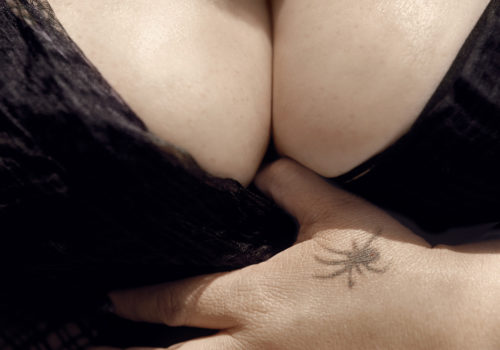At the time I was reading T. S. Eliot “The Waste Land.” There are no direct parallels, but I noticed a certain essence of his poem in the work, like a perfume that stays in the air after someone left.
I wanted to approach what is truly strange, beautiful and disorienting about the desert. Aside from vast landscapes and intimate nudes, for the first time I also photographed a few desert animals as metaphors. I was intrigued by their mysticism, like desert shamans, they have an instinct of their own. They know well their place and function in that vast space. Like the California pale moths that fly into the light. Or a black widow tattooed on a woman’s hand. I photographed a majestic black condor, then I photographed a Nephila’s golden spider web. Animals seem to understand nature’s balance and survive better than humans in the desert.
I met a lot of people who moved to the desert because they want to escape or get “off the grid”. But the desert is not for the weak of the heart. It offers an alluring American sense of freedom, but its harsh reality does not cease to remind us of our own limitations. It is shocking to face one’s own mortality. Lee Friedlander once said: “The desert is a wonderful, awful, seductive, alluring stage on which to be acting out the photography game.”
One of the homes I stayed in was built on top of this slanted rock formation. Underneath that slanted rock, there was a large shaded open area, like the shape of a mouth half open. A perfect habitat for rattlesnakes. This guy had dozens of stretched rattlesnake skins stapled on plywood board to dry out, all over the place. Hundreds of snakes live right under his rock foundation. I arrived at places and entered homes I could have never imagined before. But at the same time, being who I am, I wasn’t going to photograph the desert like “Breaking Bad.” I wanted to photograph the desert with a certain human element to relate to the beauty and the harshness. So there is a lot more landscape in this series than most.
The light is incredibly sharp; it contracts the pupils into tiny dots, making views of crystal clarity in which light and land are one. At times, I would photograph just the light by itself, its abstractions, bright sunlight and the graphic dark shadows – it had a powerful and minimal feel to it.
I photographed some people along the way, at times in their homes. Most homes I have been inside had their curtains closed. People get tired of the heat, you start feeling the weight of light, it becomes heavy. You go into people’s homes and all shades are down. Some of the desert people I met prefer to live in darkness.
You can easily loose the sense of scale in the desert.
In 1930’s, Georgia O’Keefe would often refer to what she called the “Faraway Nearby”. I photographed what seemed to have a force and scale of its own, that being macro or micro. One of these beautiful places was Grand Falls in a Navajo Reserve in Arizona. It is a larger than life multilayered waterfall system. But the water is not clear; the water carries this monochromatic sand-like tonalities with it. It looks like a waterfall of skin tones. There, water and skin become one. On the opposite scale, I found a little spring flower that was so frail. It’s very delicate image shot from above. T.S. Elliot would say that Spring season lasts only one day in the desert. The Spring flower rises in the morning and dies at night. Along a similar scale curiously I shot from the computer screen an image of California City, a planned but unrealized urban development. The roads marked out in the dust for a civilization that never really came, seen from a camera orbiting miles above the desert. Like ruins in reverse.
November 13-16, 2014
“Private” solo booth
Jackson Fine Art
Booth D51,
ParisPhoto
Grand Palais
Avenue Winston Churchill
75008 Paris
http://www.parisphoto.com
EVENT
Mona Kuhn “Private” Book Signing
Grand Palais, Paris
Private
Photographs by Mona Kuhn
Hardback / Clothbound, 112 Pages
ISBN 978-3-86930-709-1
1st Edition 10/2014
















